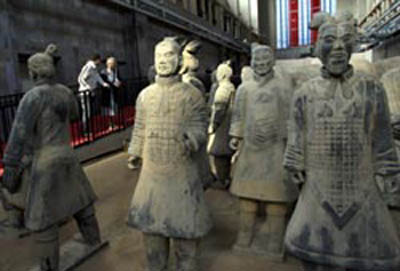Ancient terracotta soldiers from China were more popular than paintings by Dutch masters and other artifacts on their first day on show Saturday in the Drents Museum in northern Netherlands.
More than 1,000 people flocked to the museum in Assen within the first four hours of the opening of the exhibition. It was the biggest number of visitors the museum had ever received for the first day of any exhibition.
"It's the first time that terracotta warriors set their foot on Dutch soil. There has been enormous media coverage recently and we have received hundreds of calls asking for information," Ellenter Hofstede, communication manager of the Drents Museum, told Xinhua.
"We are prepared for a large crowd," she said with a smile.
Among the exhibits were 14 life-sized terracotta figures, including 10 warriors, three servants and one horse, as well as more than 200 other splendid burial gifts of gold, jade and bronze from the Qin Dynasty (221-206 BC) and the Western Han Dynasty (202 BC-9 AD).
Zhao Rong, director of the Shaanxi Provincial Administration of Cultural Heritage, said that the artifacts on show were among the best of the findings from the Qin and Han Dynasties.
At the exhibition "The Terracotta Army of Xi'an: The Treasures of the First Emperors of China," visitors could see not only terracotta warriors from the Qin Dynasty, but 96 miniature terracotta statues from the Western Han Dynasty, including warriors, servants and animals.
They could also enjoy the sight of dozens of recently unearthed objects, including life-sized bronze birds and stone-made armor.
Wu Yongqi, director of the Qin Shi Huang Terracotta Warriors Museum, said the pieces on show were comparable in quality and artistic value to the current terracotta army exhibition in the British Museum in London, although they were less in number.
The objects, all discovered near Xi'an of the Shaanxi Province, provided a glance of the magnificent Qin and Han civilization, he said, adding that the exhibition would hopefully help Dutch people to get acquainted with traditional Chinese culture and promote mutual understanding between the two peoples.
At the exhibition, many Dutch visitors were visibly struck by the images of the clay artifacts and the stories behind them.
"I'm surprised at the immense power of the ancient Chinese emperors and the way they try to maintain their kingdom in the afterworld," said M. Bakker, who had just watched a 3-D film about the genesis of the terracotta army at the museum.
He was also fascinated by the statues. "They are so beautiful, even more beautiful than I thought," Bakker said.
"Even nowadays, artists seldom make horses as beautiful as this," he said pointing to a life-sized horse from the Qin Dynasty.
Others were also impressed. "The height and the posture of the terracotta statues are very impressive," a 60-old Dutch woman said.
"Look at their faces, the expressions are so lifelike and each one is distinct from another," said the woman, who drove two hours from the southern part of the country to see the exhibition.
The exhibition, which runs through Aug. 31, was expected to draw 150,000 to 200,000 visitors, Hofstede said.
"This would be an unprecedented number considering that we usually have 90,000 visitors a year in the museum," she said.
The exhibition of the terracotta army was part of the "Go China!" project, jointly organized by the Drents Museum and the Groninger Museum, which comprises a total of five exhibitions on Chinese archaeology, Chinese Realists, avant-garde art and Chinesecon temporary art.
In Groningen, 30 kilometers in the north of Assen, the exhibition of archaeological bronze objects from China opened Saturday. The vats and cloches, cast 2,000 to 3,800 years ago, were masterpieces from the Shanghai Museum of China.
From March to November, three exhibitions on present-day Chinese art, including work by Ai Weiwei, and Chinese Realists and Avant-garde art from the 1980s and 1990s, would go on show in stages in the Groninger Museum.
"For a big part of the year, all the rooms in our museum will be occupied by exhibitions from China and its artists," said Josee Selbach, communication chief of the Groninger Museum.
"This would be the first time that our museum is solely devoted to exhibitions about one country," she said, adding that the museum expects a large number of visitors.
To show the versatile and rich culture of China, the museums also planned many other activities, including music nights, open classes of Tai Chi, and a educational program for school kids.
The "Go China!" project, designed to coincide with the Olympic Games in Beijing, would make the northern Netherlands "completely immersed in Chinese culture in 2008", according to the press releases of the museums.
(Xinhua News Agency February 3, 2008)


